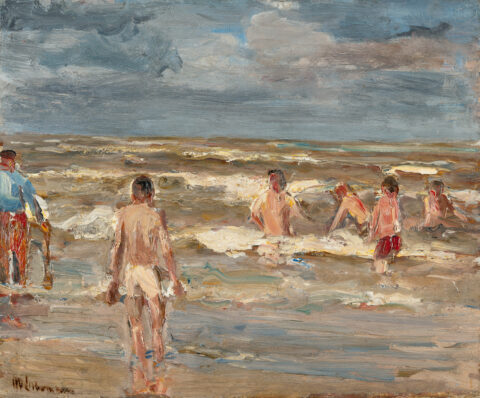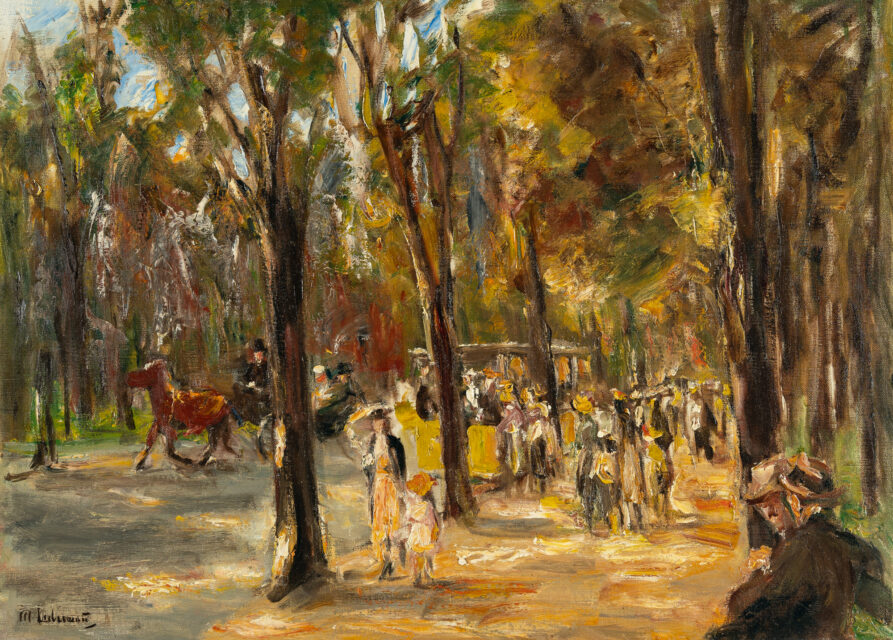
Tree-lined street in Tiergarten with figures walking, a hackney cab and a tram
Details
With a small label numbered “1162” affixed to the reverse of the stretcher and very faintly stamped “Leopold Berlin”, presumably by the Berlin based art supplies merchant Leopold Hess. Eberle 1925/30. Literature: Richardson, Holly Prentiss, Landscape in the work of Max Liebermann (vol. I-III), Phil. Diss. Brown University, Ann Arbor 1991, vol. 2, p. 242, no. 690. Exhibitions: Max Liebermann. Gedächtnisausstellung, Galerie Dr. Bühler, Munich 1985, p. 23, with col. plate. Provenance: Galerie Abels, Cologne; Galerie Bühler, Munich; private collection, Switzerland, acquired from the aforementioned in 1985; Karl & Faber, 16.7.2020, lot 403; private collection, Berlin.
Descrizione
• The Allee in Tiergarten is one of Liebermann’s most popular motifs
• A busy scene with numerous figures, a carriage and a tram from the artist’s late phase
• Unique late summer atmosphere beneath the canopy of trees that line the avenue
In Liebermann’s late work in Berlin, nature continues to be the main motif of his work. In the mid-1920s, when this painting was created, Max Liebermann was already almost 80 years old. Due to both his age and the war, he had to make do with subjects close to his home since 1915. Before that, he had spent his summers in Holland on the North Sea for many years. He was particularly fond of the large zoo, which begins just a few steps from his city residence on Pariser Platz, as well as the surroundings of his summer house on Wannsee just outside Berlin. Depictions of the Große Seestraße in Wannsee and the avenue in the Tiergarten can be found countless times in his extensive oeuvre. However, Liebermann had an inexhaustible repertoire of figures, which he constantly varied in new and creative ways so that no two works were ever alike: from finely dressed Sunday strollers in summer, children playing, horse riders and ice skaters on the lake in winter to various vehicles, whether carriages or modern cars and trams, which emphasise the urban setting. At Wannsee, it is the urban excursionists who come from nearby Berlin at the weekend who liven up the otherwise quiet street. The tree-lined avenue, an image of nature organised by man, always forms the connecting element that lends depth to the diagonal composition. It serves as a stage for the walkers, children, riders, carriages and the like, which Liebermann presents in varied and appealing compositions. However, the real protagonist of all these works is always the play of light and shadow from the sunlight that filters through the dense canopy of the avenue. Liebermann once again demonstrates his mastery as a painter in the lively interplay of light and dark, the sun’s rays breaking through and reflecting on the light-coloured dresses of the women and children, and the light blue of the sky flashing between the treetops captured with just a few quick brushstrokes. Having already explored the play of light in the foliage of the trees in his paintings created in Holland in the 1880s, he now also made it the perfect stylistic device for his urban park landscapes. “It is quite wrong to call Liebermann’s generous way of depicting nature impressionist; for his depiction is by no means based on a merely optical experience, but (is) to a certain extent a stylisation of reality, the combination of many individual observations into a great convincing impression, into a truth that expresses the meaning of the natural phenomenon.” Hans Rosenhagen, 1927 (quoted from: Robert Fleck (ed.), Max Liebermann. Wegbereiter der Moderne, Cologne 2011, p. 30).
* Tutte le informazioni includono la commissione a carico dell'acquirente (27%) senza IVA e senza garanzia. Salvo errori.
** Tutte le informazioni più la commissione a carico dell'acquirente e l'IVA e senza garanzia. Salvo errori.
*** Con riserva: L'offerta è stata accettata al di sotto del limite. L'acquisizione dell'opera potrebbe essere ancora possibile nella nostra vendita post-asta.
R = Le opere d'arte regolarmente tassate
N = Opere d'arte soggette a tassazione differenziata e provenienti da un paese non UE
Non è consentita la riproduzione e la distribuzione privata o commerciale di tutte le illustrazioni delle opere esposte nell'archivio della mostra e dell'asta. Tutti i diritti riservati.



